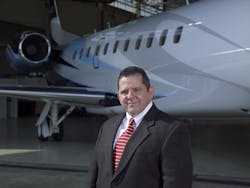Providing outstanding aircraft maintenance that meets and exceeds both safety standards and clients’ expectations comes down to training and experience — but most of all, it depends on a solid, well-functioning team.
After 40 years in the corporate aviation business, I’ve learned the hallmarks of excellent maintenance teams and what makes them tick. Follow these five tips to help your maintenance team members get into the right frame of mind to do excellent work, and take your maintenance team to the next level:
1: Treat every aircraft as if it was your own
Mediocre teams look at every aircraft as a job — or worse, they look at every repair simply as a “problem,” and a source of revenue.
The best team members treat each aircraft as though it belonged to them. A good way to get into this habit is to encourage team members to ask, “What would I want done if it were my aircraft?”
That might mean going one step beyond fixing an issue to find out what’s causing the need for a repair. Or it may mean being proactive about preventive maintenance. In our shop, it always includes making financial decisions in a responsible way. For example, we always get no less than three price quotes for every part needed in any particular situation.
Wouldn’t you shop around for the best service value if you were fixing your own jet? Wouldn’t you want every piece of a job to be done to the highest standards possible, with safety being paramount if your family were on board?
Thinking like an owner, and taking care of jets accordingly, helps teams do the right thing in each situation and the right thing for each client.
2: Get repairs done quickly to get jets back in the air
As we all know, aircraft don’t make any money sitting on the ground. In thinking like an aircraft owner, it becomes my maintenance team’s goal to get aircraft being worked on flying again as soon as safely possible.
That means being up front about how long service will take, and always being mindful that every moment spent in the shop equals time the aircraft can’t be earning money in the air.
Getting an aircraft back in service quickly shows that we understand our clients’ needs and want to be part of getting them flying again, as soon as possible, and playing an important role in making them successful.
3: Make communication a priority
Communicating clearly and often is key, both for our internal team and with our clients.
Sometimes maintenance folks can be very good at the technical aspects of their job, but not so strong on “people skills” or communication. We make it our job to be good at both.
It’s our policy to provide daily status reports on all jet repairs. Since clients’ earning potential is grounded for as long as their jets are grounded for maintenance, that extra step lets them know that we’re working as quickly as possible to get the service done so they’re flying again as quickly as possible.
Make sure your teams understand the importance of communication, and if you don’t currently have a standard or system for touching base with clients (such as the daily updates) it might be time to put that into place.
4: Recognize talent and promote “potential”
Your strong performers of today will be your team leaders and role models of tomorrow.
“Promoting potential” means seeing when a team member is ready for more responsibility — even before they’d volunteer for the job. For example, I took two line maintenance technicians and promoted them to supervisors. I think they surprised themselves at how well they handled the bigger jobs.
Technicians are much savvier today than they were 20 to 30 years ago, when it comes to knowing what their personal and professional goals are. Whether it is a raise or promotion, they know they must continually move their career forward, making them more prepared to move from a line technician to a supervisory position. It is critical to continually support them to make these transitions/promotions successful and to give them the tools they need to achieve their potential.
Keep an eye out for promising talent and team members who show potential. Giving them that next opportunity keeps them engaged and feeling valued on your team — which means over time they’ll choose to keep their experience and expertise in your shop, rather than joining a competitor’s outfit just to get to that “next level.”
5: Run an efficient operation
Being good at what you do is one thing — but running an efficient operation requires another level of focus and a commitment to ongoing improvement.
Examine each aspect of your operation to see where bottlenecks are and what causes headaches. Often, inefficiencies can result in unnecessarily increased expenses or slower repair times.
Be proactive about finding ways to increase efficiency in your shop. Ask your team members for input — they’re definitely the ones who know what the problem areas are, and likely have ideas for how to solve them. Be sure to check in with customers from time to time as well, whether it’s through a customer satisfaction survey or simply asking if there’s any aspect of your service that could be improved.
What you’ll learn will help you reduce inefficiencies — and that will ultimately result in a more smoothly running, cost-effective shop that delivers higher-quality service (and in which maintenance team members are happier to work).
All of these points can be achieved if you have full buy-in from your team. Once that is achieved, and everyone is pulling in the same direction, five tips become easy to achieve.
I hope these tips, learned through decades of hands-on experience, will help you turn your team into a top-notch maintenance organization. A team that’s functioning optimally not only makes your shop a better place to work — it means you can all work together to deliver better results to your clients.
Ralph Michielli, vice president and director of maintenance, Hawthorne Global Aviation, brings more than three decades of experience in business jet aviation to Hawthorne, and helped launch ExcelAire in 1993. He oversees all maintenance operations at Hawthorne Global Aviation and also serves as technical liaison between Hawthorne and its aircraft owners and is a FAA-licensed Airframe and Powerplant technician specializing in jet aircraft.



